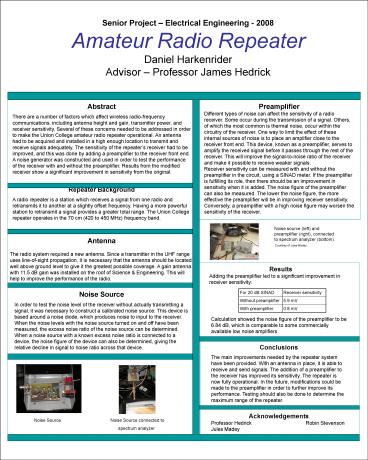Senior Project PowerPoint PPT Presentation
1 / 1
Title: Senior Project
1
Senior Project Electrical Engineering -
2008Amateur Radio RepeaterDaniel
HarkenriderAdvisor Professor James Hedrick
Abstract There are a number of factors which
affect wireless radio-frequency communications,
including antenna height and gain, transmitter
power, and receiver sensitivity. Several of these
concerns needed to be addressed in order to make
the Union College amateur radio repeater
operational. An antenna had to be acquired and
installed in a high enough location to transmit
and receive signals adequately. The sensitivity
of the repeaters receiver had to be improved,
and this was done by adding a preamplifier to the
receiver front end. A noise generator was
constructed and used in order to test the
performance of the receiver with and without the
preamplifier. Results from the modified receiver
show a significant improvement in sensitivity
from the original. Repeater Background A radio
repeater is a station which receives a signal
from one radio and retransmits it to another at a
slightly offset frequency. Having a more powerful
station to retransmit a signal provides a greater
total range. The Union College repeater operates
in the 70 cm (420 to 450 MHz) frequency band.
Preamplifier Different types of noise can affect
the sensitivity of a radio receiver. Some occur
during the transmission of a signal. Others, of
which the most common is thermal noise, occur
within the circuitry of the receiver. One way to
limit the effect of these internal sources of
noise is to place an amplifier close to the
receiver front end. This device, known as a
preamplifier, serves to amplify the received
signal before it passes through the rest of the
receiver. This will improve the signal-to-noise
ratio of the receiver and make it possible to
receive weaker signals. Receiver sensitivity can
be measured with and without the preamplifier in
the circuit, using a SINAD meter. If the
preamplifier is fulfilling its role, then there
should be an improvement in sensitivity when it
is added. The noise figure of the preamplifier
can also be measured. The lower the noise figure,
the more effective the preamplifier will be in
improving receiver sensitivity. Conversely, a
preamplifier with a high noise figure may worsen
the sensitivity of the receiver.
Noise source (left) and preamplifier (right),
connected to spectrum analyzer (bottom).
Courtesy of Jules Madey
Antenna The radio system required a new antenna.
Since a transmitter in the UHF range uses
line-of-sight propagation, it is necessary that
the antenna should be located well above ground
level to give it the greatest possible coverage.
A gain antenna with 11.5 dB gain was installed on
the roof of Science Engineering. This will help
to improve the performance of the radio.
Results Adding the preamplifier led to a
significant improvement in receiver sensitivity
Noise Source In order to test the noise level of
the receiver without actually transmitting a
signal, it was necessary to construct a
calibrated noise source. This device is based
around a noise diode, which produces noise to
input to the receiver. When the noise levels with
the noise source turned on and off have been
measured, the excess noise ratio of the noise
source can be determined. When a noise source
with a known excess noise ratio is connected to a
device, the noise figure of the device can also
be determined, giving the relative decline in
signal to noise ratio across that device.
For 20 dB SINAD Receiver sensitivity
Without preamplifier 5.9 mV
With preamplifier 0.8 mV
Calculation showed the noise figure of the
preamplifier to be 6.84 dB, which is comparable
to some commercially available low noise
amplifiers. Conclusions The main improvements
needed by the repeater system have been provided.
With an antenna in place, it is able to receive
and send signals. The addition of a preamplifier
to the receiver has improved its sensitivity. The
repeater is now fully operational. In the future,
modifications could be made to the preamplifier
in order to further improve its performance.
Testing should also be done to determine the
maximum range of the repeater. Acknowledgements
Professor Hedrick Robin Stevenson Jules Madey
Noise Source
Noise Source connected to
spectrum analyzer

